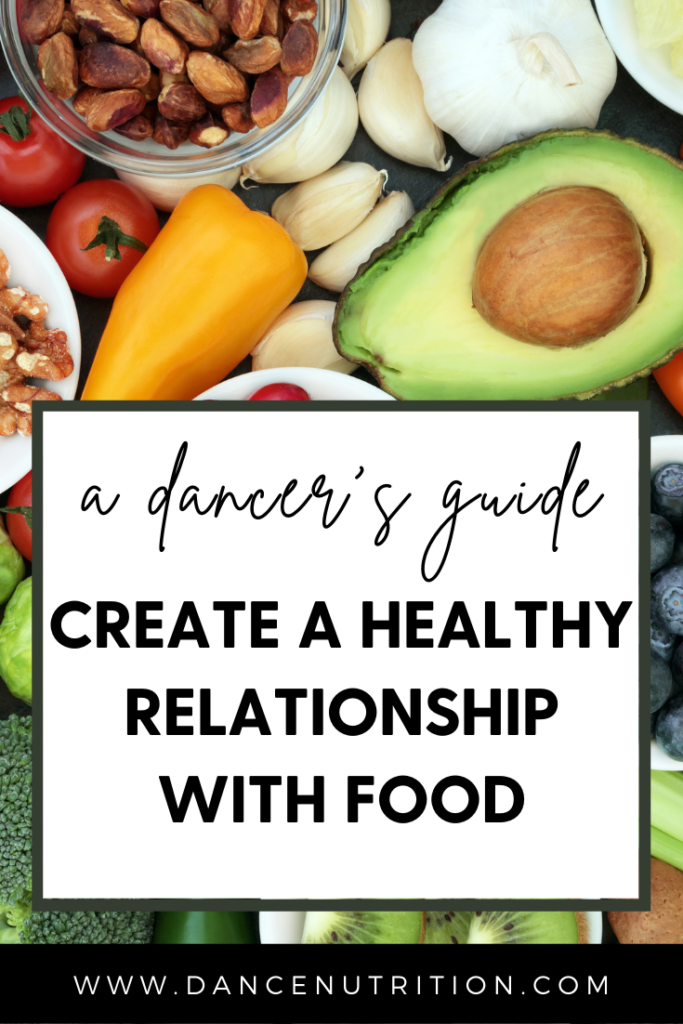Absolutely— but it starts with redefining what a “healthy” relationship with food really means.
For many dancers, food becomes something to control. Whether it’s cutting out entire food groups, avoiding favorite meals, or eating by strict rules in the name of performance or body goals, these efforts often backfire. Instead of better health or improved dancing, they usually lead to increased body dissatisfaction, chronic stress around eating, and a heightened risk for disordered eating behaviors.
Your relationship with food is more than what’s on your plate— it’s the foundation of a sustainable, fulfilling dance career. And while “positive” might sound ideal, it can also feel unrealistic— especially if you’re struggling. That’s why I encourage dancers to aim for a working relationship with food: one that evolves, grows, and supports you through every stage of your journey.
A strong relationship with food is rooted in curiosity— not judgment. It allows you to recognize cravings as your body’s way of communicating, and to respond with both self-compassion and nutritional understanding. Through this process, dancers can identify which foods support them physically, mentally, and emotionally.
Here’s a step-by-step guide to help dancers build a healthier, more functional relationship with food:
5 Steps To Improving Your Relationship With Food
#1: Unlearn The Dieting Mentality
The first step in The Healthy Dancer® framework is to dismantle the diet culture so prevalent in dance. Diet culture prioritizes thinness and weight loss over well-being, often at the expense of performance and health. In the dance world, this can be especially damaging. Here’s how dancers can start unlearning those beliefs.
#2: Grant Unconditional Permission to Eat
Restrictive food rules like “I can only eat this if I’ve worked out” or “I should save calories for later” don’t serve your long-term health. True nourishment starts by removing these conditions. Make a list of foods that bring you joy and begin reintroducing them— no guilt, no judgment. If fear of “food addiction” is holding you back, here’s why that belief is often a myth, and how releasing food guilt can support your healing.
#3: Practice Food Neutrality
Labeling foods as “good” or “bad” assigns moral value to your choices and triggers feelings of shame when those choices don’t align with your expectations. Practicing food neutrality allows dancers to make food decisions from a place of self-care rather than self-control. This approach can be a powerful tool for building trust in your body.
#4: Embrace Food Flexibility
Life as a dancer isn’t always predictable— your meals shouldn’t have to be either. Food flexibility means navigating changing schedules and social situations without anxiety or rigid food rules. It’s a key part of making nutrition sustainable. Learn to build more flexibility into your food choices, even as a busy dancer.
#5: Try Mindful Eating Practices
Mindful eating is about tuning into your body’s cues— hunger, fullness, satisfaction, and energy— so you can eat in a way that feels supportive and sustainable. It’s less about perfection and more about presence. This awareness allows you to process your body’s feedback, determining which foods support you and which don’t. Here’s how dancers can apply mindful eating to their everyday routines.
Key Takeaways: Your Relationship with Food Matters
If you’re still relying on restriction, “clean” eating, or excessive supplementation to boost your performance, consider this: what if your body actually needs more? More food, more variety, and sometimes, even more rest. Supporting your long-term potential might require you to do the opposite of what diet culture has taught.
Food is fuel— but it’s also connection, pleasure, and culture. And dancers deserve all of it.



